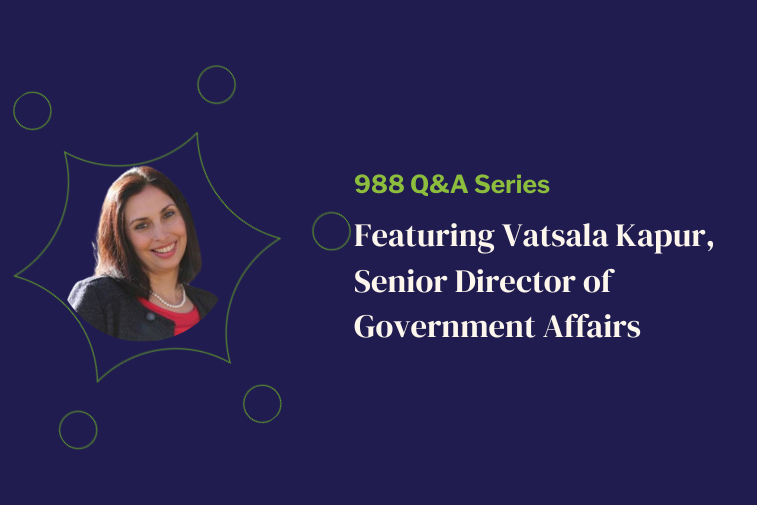Vatsala Kapur is the senior director of government affairs at Bamboo Health. In the latest installment of our 988 Q&A series, we sit down with her to discuss 988 preparedness at the state level and what needs to happen infrastructure-wise to make the initiative sustainable beyond the recent July 16th launch.
Jump to:
- Previous experience with the government sector
- How often are conversations around 988 coming up?
- Where do you see states putting emphasis when supporting 988?
- Are there some states that simply have more fiscal resources to support the lifeline?
- Anything else keeping states up at night as it relates to lifeline preparedness?
- What’s the advice you would give to officials as they seek to navigate the 988 mandate?
- What does the initial 988 mandate look like? How has the federal government been helping?
- Are you having conversations with states that are forward-thinking about 988 sustainability?
- Are there any misconceptions about the 988 mandate that surprised you?
- Where does Bamboo Health fit when it comes to helping states comply with the 988 mandate?
- Anything else you want readers to know about 988 from a policy perspective?
Let’s talk a little bit about your journey to Bamboo Health. Can you tell us about your previous experience specific to the government sector?
I am passionate about improving health and healthcare, and more specifically, tackling care obstacles that are impacting underserved communities. The last decade of my career has reflected that mission. I’ve spent most of my professional life working in health and health IT policy, which included positions within two governor’s offices as well as with the U.S. Department of Health and Human Services.
I’ve found that when the industry is looking to overcome healthcare challenges, technology often is an afterthought. This is partly because health IT is not well understood. As a result, I developed an expertise in technology-related issues in the healthcare space, which ultimately led me to Bamboo Health. Today, I’m growing a team responsible for managing all government affairs work, supporting strategy with hospital associations and health information exchanges and working with state governments.
So, in your position you are often talking to healthcare policy leadership at the state level. How often are conversations around 988 coming up?
I’m hearing a lot about the 988 Suicide and Crisis Lifeline. I would say there is a spectrum of preparedness among states. Some states are meeting the letter of the law and others are focused on meeting the letter and the spirit of the law. This is often driven by the state funding environment, as states are considering how to find sustainability for their 988 systems.
Where do you currently see states putting the greatest emphasis when it comes to supporting 988?
Right now, a lot of states are focused on ensuring that the call centers are ready for additional call volume. Not many are thinking about creating an end-to-end system that helps to meet the holistic needs of this population, including dispatch and referral. A lot of states appear to be in wait-and-see mode right now because they’re trying to gauge what the call volume is going to look like.
My hypothesis is that over time – maybe over a few years – we’re going to see a diversion of calls from 911 to 988, and as a result, intake call volume will steadily increase. This should have a profound impact on how states invest in a system that supports these individuals over the lifecycle of their needs.
Let’s talk about 988 funding. Are there some states that simply have more fiscal resources to support the lifeline?
For starters, there is federal funding available to all states via the Substance Abuse and Mental Health Services Association (SAMHSA), but we are also seeing a lot of states exploring user fees to fund 988. It’s important to note that this isn’t a fee for calling into the hotline, rather it’s a small fee that’s added to cell phone subscriber bills. There are also some states that are exploring allocating funds from 911 and using them for 988 instead.
Anything else keeping states up at night as it relates to lifeline preparedness?
Besides call center staffing and lifeline funding, the biggest struggle states are starting to face is sustainability. States are wondering how they will get this initiative up and running, and then sustain it for years to come – just like 911.
It’s often difficult to recall that 911 only launched in 1968, and it’s taken decades to get the initiative where it is today. Given that, we can only expect the same with 988’s rollout. Luckily, it’s clear that the public supports 988. In fact, a recent poll conducted by the National Alliance on Mental Illness found that 89% agree that everyone, regardless of location or income, deserves access to quality mental health crisis responses and care. I think we’ll get there but we’ll need to have the funding in place and provide states with the time to determine how to best stand up their efforts.
What’s the advice you would give to officials as they seek to navigate the 988 mandate?
Anyone who’s had personal experiences with an individual in a behavioral health crisis knows that it is hard. We don’t have a holistic system for managing the needs of individuals with behavioral health conditions; rather, individuals and their caregivers oftentimes must cobble resources together.
My biggest suggestion to states is to take stock of their existing assets and infrastructure, both in terms of the call center capability as well as their referral network. Then, I’d urge them to think from a systems perspective about how to bring all the necessary infrastructure together in a patient-centric way.
More specifically, they should be looking at managing the patient referral process so it’s more streamlined and transparent. States can play an important role in helping create more systematization for when, where and how to get individuals the care they need when they need it.
I also think it’s important for states to tap individuals that have personally been in crisis and gain their perspective about what works and what doesn’t, so that whatever system is ultimately put in place is responsive to the needs of the individuals calling into 988, those staffing the call centers, and everyone else that touches that individual.
So what does the initial 988 mandate look like? How involved has the federal government been to help states prepare?
To date, the federal government has been giving states latitude in terms of implementation of 988 while also providing best practices, toolkits and other resources. That means every state from Alaska to Alabama is going to look different in terms of their 988 readiness. There are many states that have a lot of rural and frontier counties where access to behavioral health services was an issue even before 988 and those issues can’t be fixed overnight.
In your role at Bamboo Health are you having conversations with states today that are really forward-thinking about longer term 988 sustainability?
Bamboo Health recently partnered with two states to help them plan for their longer-term crisis responses. Further, all the states we have been partnering with are looking ahead. For example, many are determining how to sync 988 with their pre-existing 211 number, which helps people access social services in their area.
Are there any misconceptions about the 988 mandate that surprised you?
Leading up to July 16, some people thought that a switch would be flipped, and everything was going to operate seamlessly. Obviously, states have now learned that it’s not going to happen that fast, just as it didn’t with the implementation of 911.
Today, we take the 911 system for granted – when someone calls, dispatch happens quickly and expeditiously, but it took years for that to become the reality. From a government standpoint, I feel like there needs to be more of a policy construct or requirements tied to SAMHSA funding to really push states to think about all the infrastructure and be able to plan and pay for those needs holistically.
So where does Bamboo Health fit when it comes to helping states comply with the 988 mandate?
Bamboo Health can be part of the longer-term solution to help states stand up a successful 988 program and continue it for years to come. With Bamboo Health’s Crisis Management System, 988 call centers are able to quickly identify resources and mobile response teams, and help facilitate individuals receiving the care they need, at the right time.
As a technology provider, we have gained extensive experience. We’re currently working with 14 states, as they navigate the behavioral health resource delivery landscape. As a team, we’ve learned a lot about what works, what doesn’t and what challenges states consistently face. We are well-positioned to support states in their 988 response and be thought partners in optimizing existing and planned resources.
Anything else you want readers to know about 988 from a policy perspective?
From a policy perspective, 988 is momentous. It is a bipartisan issue, one of the few that cut across the current divide in Washington D.C. As an industry, I believe we have an opportunity to positively impact our nation’s growing behavioral health challenges. However, as a first step we need to offer more assistance to states as they try to navigate the best path forward, including funding. The federal government can play a role in that, and we can, too.
For Additional Information
If you would like to learn more about 988 or how Bamboo Health can help support infrastructure development efforts for the national behavioral health lifeline, please check out our crisis management playbook.



